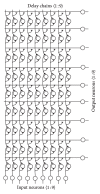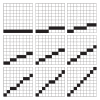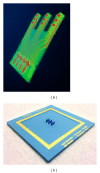Modeling the formation process of grouping stimuli sets through cortical columns and microcircuits to feature neurons
- PMID: 24369455
- PMCID: PMC3863480
- DOI: 10.1155/2013/290358
Modeling the formation process of grouping stimuli sets through cortical columns and microcircuits to feature neurons
Abstract
A computational model of a self-structuring neuronal net is presented in which repetitively applied pattern sets induce the formation of cortical columns and microcircuits which decode distinct patterns after a learning phase. In a case study, it is demonstrated how specific neurons in a feature classifier layer become orientation selective if they receive bar patterns of different slopes from an input layer. The input layer is mapped and intertwined by self-evolving neuronal microcircuits to the feature classifier layer. In this topical overview, several models are discussed which indicate that the net formation converges in its functionality to a mathematical transform which maps the input pattern space to a feature representing output space. The self-learning of the mathematical transform is discussed and its implications are interpreted. Model assumptions are deduced which serve as a guide to apply model derived repetitive stimuli pattern sets to in vitro cultures of neuron ensembles to condition them to learn and execute a mathematical transform.
Figures





References
-
- Buonomano DV, Maass W. State-dependent computations: spatiotemporal processing in cortical networks. Nature Reviews Neuroscience. 2009;10(2):113–125. - PubMed
-
- Sadeghi S, Ramanathan K. A Hubel Wiesel model of early concept generalization based on local correlation of input features. Proceedings of the International Joint Conference on Neural Network (IJCNN '11); August 2011; San Jose, Calif, USA. pp. 709–716.
-
- Quiroga RQ, Reddy L, Kreiman G, Koch C, Fried I. Invariant visual representation by single neurons in the human brain. Nature. 2005;435(7045):1102–1107. - PubMed
-
- Hubel DH. Evolution of ideas on the primary visual cortex, 1955–1978: a biased historical account—Nobel lecture, 8 December 1981. Bioscience Reports. 1982;2(7):435–469. - PubMed
Publication types
MeSH terms
LinkOut - more resources
Full Text Sources
Other Literature Sources

